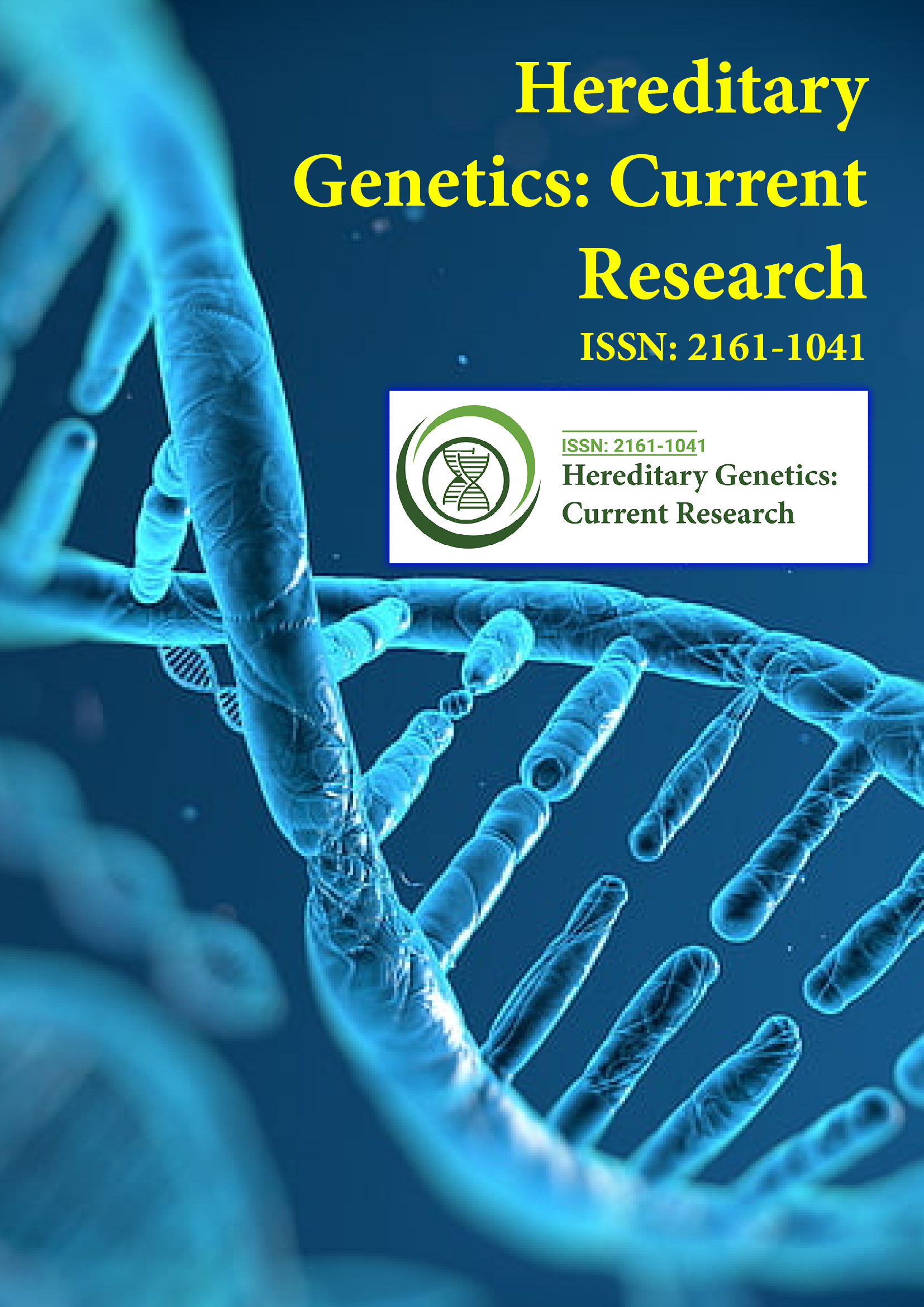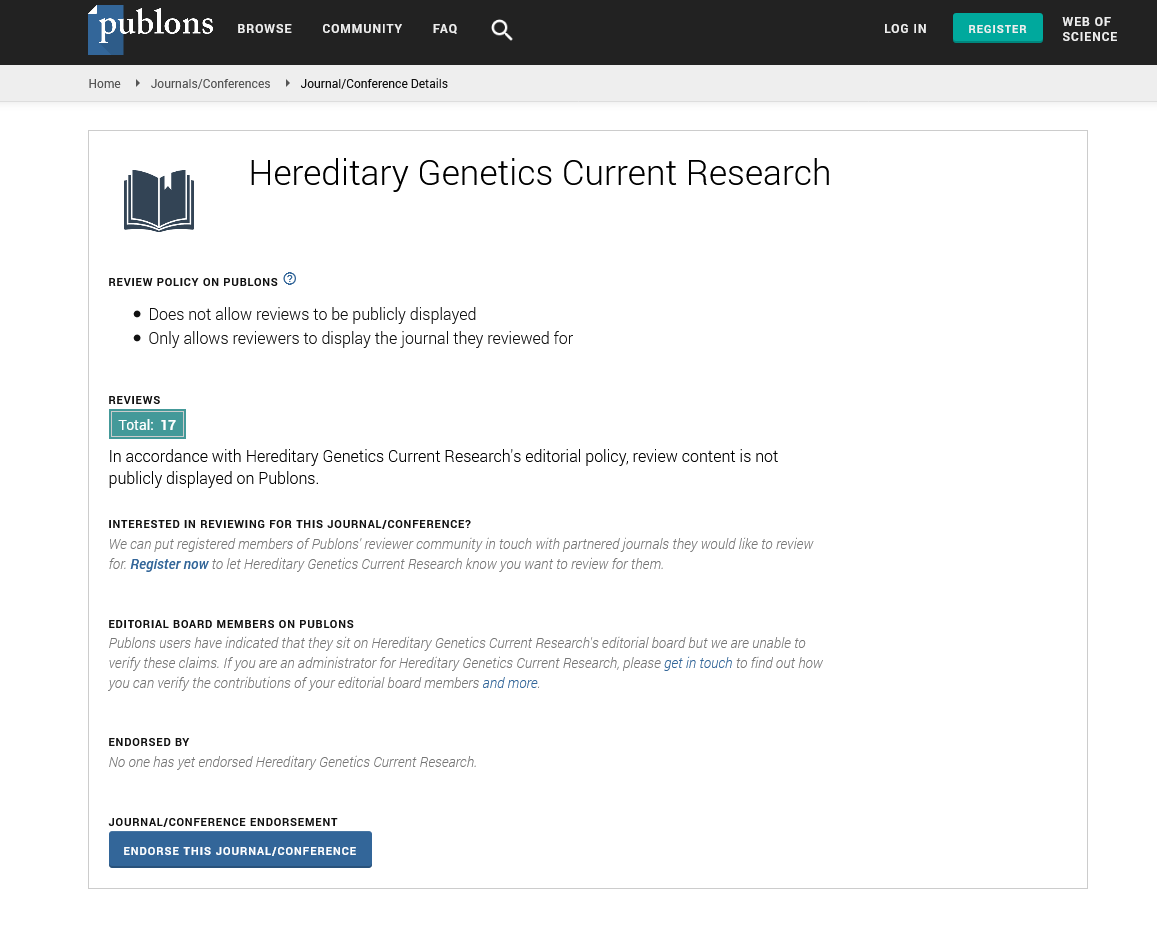Indexed In
- Open J Gate
- Genamics JournalSeek
- CiteFactor
- RefSeek
- Hamdard University
- EBSCO A-Z
- NSD - Norwegian Centre for Research Data
- OCLC- WorldCat
- Publons
- Geneva Foundation for Medical Education and Research
- Euro Pub
- Google Scholar
Useful Links
Share This Page
Journal Flyer

Open Access Journals
- Agri and Aquaculture
- Biochemistry
- Bioinformatics & Systems Biology
- Business & Management
- Chemistry
- Clinical Sciences
- Engineering
- Food & Nutrition
- General Science
- Genetics & Molecular Biology
- Immunology & Microbiology
- Medical Sciences
- Neuroscience & Psychology
- Nursing & Health Care
- Pharmaceutical Sciences
Short Communication - (2023) Volume 12, Issue 2
Enhancing Diagnostic Accuracy: The Significance of RNA Analysis in Hereditary Cancer Testing
Jiang Mengchao*Received: 02-Jun-2023, Manuscript No. HGCR-23-22097; Editor assigned: 05-Jun-2023, Pre QC No. HGCR-23-22097 (PQ); Reviewed: 19-Jun-2023, QC No. HGCR-23-22097; Revised: 26-Jun-2023, Manuscript No. HGCR-23-22097 (R); Published: 03-Jul-2023, DOI: 10.35248/2161-1041.23.12.247
Description
Genetic testing is critical in identifying individuals at risk of hereditary cancer, allowing for early intervention and personalized treatment regimens. Traditional genetic testing methods focus on DNA analysis, but recent advancements have focused on the significance of RNA analysis in improving diagnostic accuracy and therapeutic decision-making. By examining gene expression patterns and identifying aberrant RNA transcripts, RNA analysis offers a deeper understanding of cancer biology, enables identification of disease-causing variants, and facilitates targeted treatment approaches. Hereditary cancer is characterized by the presence of specific gene mutations that increase an individual's susceptibility to developing certain types of cancer [1]. Genetic testing has revolutionized the field of oncology by allowing the identification of these mutations, enabling early detection, risk assessment, and personalized treatment plans [2]. Traditionally, genetic testing has focused on analyzing DNA, primarily through techniques like Sanger sequencing or next-generation sequencing (NGS). However, DNA analysis alone may not capture the full complexity of cancer genetics, as it does not account for post-transcriptional modifications or gene expression levels. RNA analysis provides a complementary approach to DNA testing in hereditary cancer diagnosis [3]. Unlike DNA, RNA reflects the active gene expression patterns within cells, providing insights into the functionality and dysregulation of genes. By examining RNA transcripts, researchers can identify alterations in gene expression that are associated with cancer development. RNA analysis techniques, such as RNA sequencing (RNA-seq), can detect alternative splicing, fusion genes, and other gene expression abnormalities that may be missed by DNA sequencing alone [4]. In Comprehensive Assessment of Gene Expression, RNA analysis allows a more comprehensive assessment of gene expression patterns, enabling the identification of specific gene signatures associated with hereditary cancer [5]. By comparing the RNA profiles of healthy individuals and cancer patients, researchers can identify differentially expressed genes that may be indicative of disease progression or treatment response [6]. RNA analysis can detect splice variants and fusion genes that arise due to alterations in RNA processing. These aberrations can contribute to tumour development and growth [7]. Identifying these variants can provide crucial information for diagnosis, prognosis, and potential therapeutic targets. Genetic testing often reveals variants of unknown significance (VUS) that have uncertain clinical implications. RNA analysis can shed light on the functional consequences of VUS by assessing their impact on gene expression [8]. This information aids in determining the pathogenicity of VUS and guiding treatment decisions. The integration of RNA analysis into routine genetic testing for hereditary cancer provide great potential for improving clinical outcomes [9]. By incorporating RNA-based assays alongside DNA analysis, clinicians can obtain a more comprehensive understanding of a patient's cancer genetics. This knowledge can guide treatment decisions, including the selection of targeted therapies or participation in clinical trials. Despite its potential, RNA analysis for hereditary cancer is still in the early stages of development. Further research is needed to establish standardized protocols, validate its clinical utility, and overcome technical challenges such as RNA degradation and sample preparation [10]. Additionally, collaboration between researchers, clinicians, and genetic counselors is vital to ensure the effective translation of RNA analysis into clinical practice.
Conclusion
The incorporation of RNA analysis in genetic testing for hereditary cancer represents a significant advancement in precision medicine. By providing insights into gene expression patterns and functional consequences of genetic variants, RNA analysis enhances diagnostic accuracy, refines risk assessment, and improves treatment strategies. While challenges remain, the ongoing progress in RNA analysis techniques and the integration of multiomics approaches provide great potential for a more comprehensive understanding of hereditary cancer and improved patient outcomes.
References
- Brnich SE, Abou Tayoun AN, Couch FJ, Cutting GR, Greenblatt MS, Heinen CD, et al. Recommendations for application of the functional evidence PS3/BS3 criterion using the ACMG/AMP sequence variant interpretation framework. Genome Med. 2020;12(1):1-2.
[Crossref] [Google Scholar] [PubMed]
- Feliubadaló L, López-Fernández A, Pineda M, Díez O, Del Valle J, Gutiérrez-Enríquez S, et al. Opportunistic testing of BRCA1, BRCA2 and mismatch repair genes improves the yield of phenotype driven hereditary cancer gene panels. Int J Cancer. 2019;145(10):2682-2691.
[Crossref] [Google Scholar] [PubMed]
- Gelli E, Colombo M, Pinto AM, De Vecchi G, Foglia C, Amitrano S, et al. Usefulness and limitations of comprehensive characterization of mRNA splicing profiles in the definition of the clinical relevance of BRCA1/2 variants of uncertain significance. Cancers. 2019;11(3):295.
[Crossref] [Google Scholar] [PubMed]
- Abou Tayoun AN, Pesaran T, DiStefano MT, Oza A, Rehm HL, Biesecker LG, et al. ClinGen Sequence Variant Interpretation Working Group (ClinGen SVI). Recommendations for interpreting the loss of function PVS1 ACMG/AMP variant criterion. Hum Mutat. 2018;39(11):1517-1524.
[Crossref] [Google Scholar] [PubMed]
- Lee K, Krempely K, Roberts ME, Anderson MJ, Carneiro F, Chao E et al. Specifications of the ACMG/AMP variant curation guidelines for the analysis of germline CDH1 sequence variants. Human mutation. 2018;39(11):1553-1568.
[Crossref] [Google Scholar] [PubMed]
- Soto JL, Blanco I, Díez O, Planells JG, Lorda I, Matthijs G, et al. Consensus document on the implementation of next generation sequencing in the genetic diagnosis of hereditary cancer. Med Clin. 2018;151(2):80-e1.
[Crossref] [Google Scholar] [PubMed]
- Moles-Fernández A, Duran-Lozano L, Montalban G, Bonache S, López-Perolio I, Menéndez M, et al. Computational tools for splicing defect prediction in breast/ovarian cancer genes: how efficient are they at predicting RNA alterations? Front Genet. 2018;9:366.
[Crossref] [Google Scholar] [PubMed]
- Couch FJ, Shimelis H, Hu C, Hart SN, Polley EC, Na J, et al. Associations between cancer predisposition testing panel genes and breast cancer. JAMA Oncol. 2017;3(9):1190-1196.
[Crossref] [Google Scholar] [PubMed]
- Raskin L, Guo Y, Du L, Clendenning M, Rosty C, Lindor NM, et al. Colon Cancer Family Registry. Targeted sequencing of established and candidate colorectal cancer genes in the Colon Cancer Family Registry Cohort. Oncotarget. 2017;8(55):93450.
[Crossref] [Google Scholar] [PubMed]
- Farber-Katz S, Hsuan V, Wu S, Landrith T, Vuong H, Xu D, et al. Quantitative analysis of BRCA1 and BRCA2 germline splicing variants using a novel RNA-massively parallel sequencing assay. Front Oncol. 2018;8:286.
[Crossref] [Google Scholar] [PubMed]
Citation: Mengchao J (2023) Enhancing Diagnostic Accuracy: The Significance of RNA Analysis in Hereditary Cancer Testing. Hereditary Genet. 12:247.
Copyright: © 2023 Mengchao J. This is an open-access article distributed under the terms of the Creative Commons Attribution License, which permits unrestricted use, distribution, and reproduction in any medium, provided the original author and source are credited.

